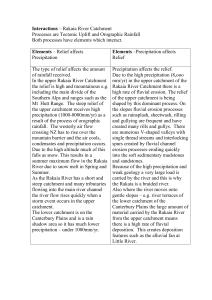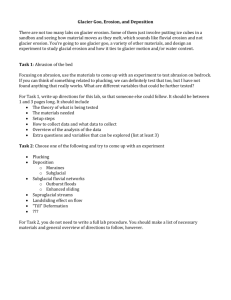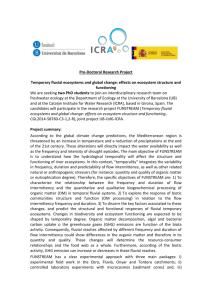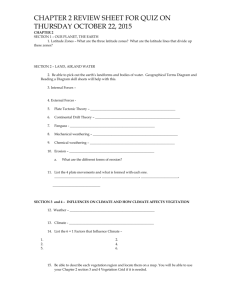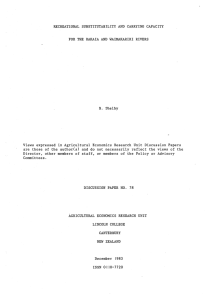Human Modifications in the Rakaia River Catchment - mhc
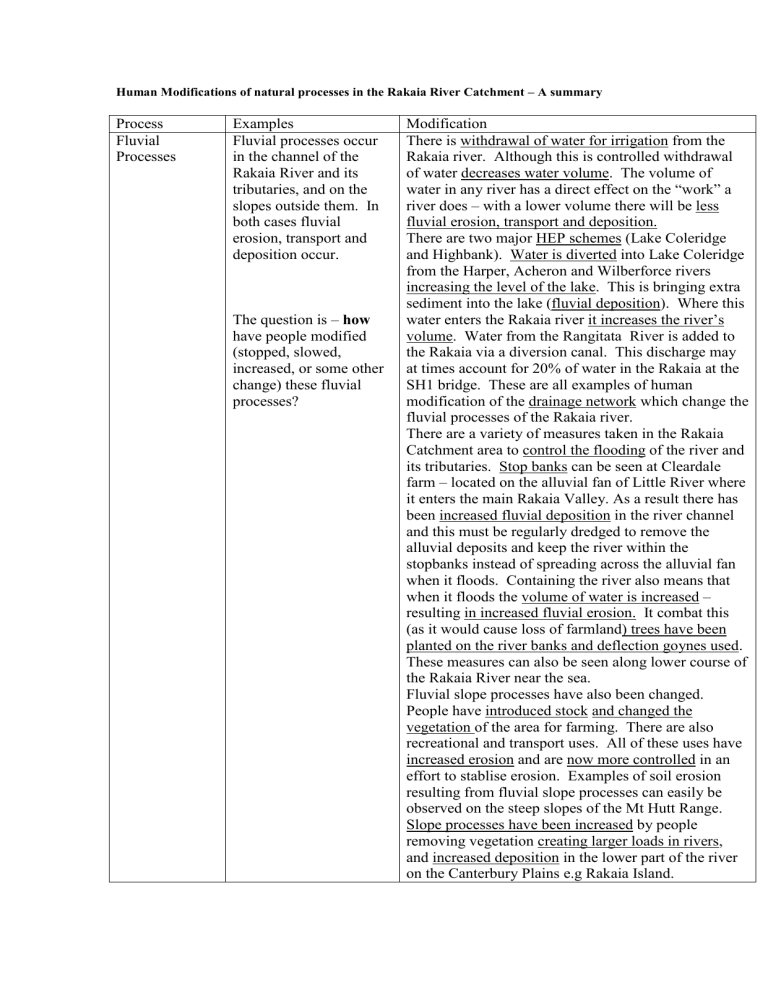
Human Modifications of natural processes in the Rakaia River Catchment – A summary
Process
Fluvial
Processes
Examples
Fluvial processes occur in the channel of the
Rakaia River and its tributaries, and on the slopes outside them. In both cases fluvial erosion, transport and deposition occur.
The question is – how have people modified
(stopped, slowed, increased, or some other change) these fluvial processes?
Modification
There is withdrawal of water for irrigation from the
Rakaia river. Although this is controlled withdrawal of water decreases water volume. The volume of water in any river has a direct effect on the “work” a river does – with a lower volume there will be less fluvial erosion, transport and deposition.
There are two major HEP schemes (Lake Coleridge and Highbank). Water is diverted into Lake Coleridge from the Harper, Acheron and Wilberforce rivers increasing the level of the lake. This is bringing extra sediment into the lake (fluvial deposition). Where this water enters the Rakaia river it increases the river’s volume. Water from the Rangitata River is added to the Rakaia via a diversion canal. This discharge may at times account for 20% of water in the Rakaia at the
SH1 bridge. These are all examples of human modification of the drainage network which change the fluvial processes of the Rakaia river.
There are a variety of measures taken in the Rakaia
Catchment area to control the flooding of the river and its tributaries. Stop banks can be seen at Cleardale farm – located on the alluvial fan of Little River where it enters the main Rakaia Valley. As a result there has been increased fluvial deposition in the river channel and this must be regularly dredged to remove the alluvial deposits and keep the river within the stopbanks instead of spreading across the alluvial fan when it floods. Containing the river also means that when it floods the volume of water is increased – resulting in increased fluvial erosion. It combat this
(as it would cause loss of farmland) trees have been planted on the river banks and deflection goynes used.
These measures can also be seen along lower course of the Rakaia River near the sea.
Fluvial slope processes have also been changed.
People have introduced stock and changed the vegetation of the area for farming. There are also recreational and transport uses. All of these uses have increased erosion and are now more controlled in an effort to stablise erosion. Examples of soil erosion resulting from fluvial slope processes can easily be observed on the steep slopes of the Mt Hutt Range.
Slope processes have been increased by people removing vegetation creating larger loads in rivers, and increased deposition in the lower part of the river on the Canterbury Plains e.g Rakaia Island.
Tectonic – folding and faulting
Climate
Processes
Vegetation
Succession
Wind Processes
– aeolian
Folding and Faulting are still active processes and have created the high relief of the catchment e.g. Southern Alps, Mt
Hutt Range
Rainfall processes occur, cold temperatures are also essential for the freeze/thaw – frost action which creates scree slopes
This is the process of vegetation starting on a bare slope and developing to the climax vegetation.
Fluvial erosion is constantly removing vegetation and creating a bare surface to be colonised by vegetation.
– but have people changed this process?
Wind processes include wind erosion, transport and deposition
People can not really change the process – they do modify the results of it (the relief) in a minor way e.g. road cuttings
People can not really change these processes – they can modify the results (e.g.control water flow after rainfall, snow moved to new location)
People have interrupted this process – they have changed the vegetation cover of the area. Forest was removed to plant grassland for farming. There are many examples of introduced species of vegetation which would not be found in the are if people had not introduced them. Shelter belts of introduced trees are common on farms throughout the area. Gorse and broom are found in uncultivated areas, including the on river flats outside the current river channel. People also disturb vegetation when making roads. The introduction of browsing animals e.g. deer has also affected the vegetation.
People do change this by planting shelter belts of trees and either adding or removing vegetation cover – this alters the processes.
